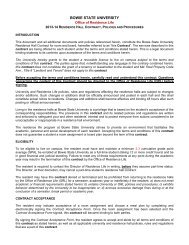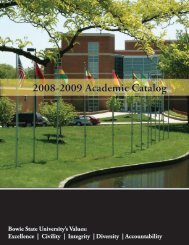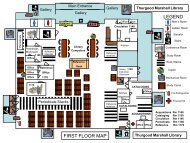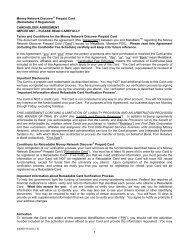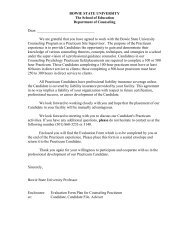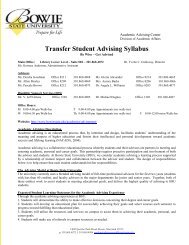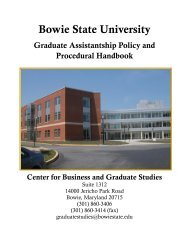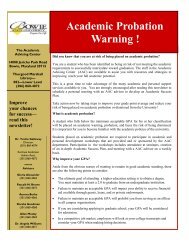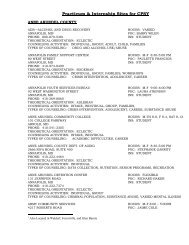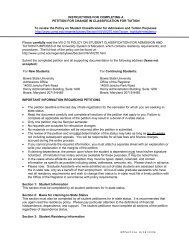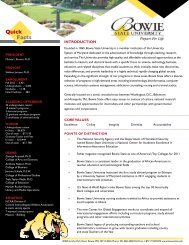2009-2010 - Bowie State University
2009-2010 - Bowie State University
2009-2010 - Bowie State University
You also want an ePaper? Increase the reach of your titles
YUMPU automatically turns print PDFs into web optimized ePapers that Google loves.
MATH 116 INTRO TO MATHEMATICAL IDEAS 3 CREDITS<br />
Prerequisite(s): DVMT 090 or MATH 099, or direct placement by way of the <strong>University</strong>‐approved Mathematics Placement Test or by way of<br />
transfer credit. Proceeding from a liberal arts perspective, we sample the elementary principles and methods of five distinct areas of<br />
mathematics: logic, set theory, probability, statistics, and geometry.<br />
MATH 118 FINITE MATHEMATICS 3 CREDITS<br />
Prerequisite(s): DVMT 090 or MATH 099 or direct placement by way of the <strong>University</strong>‐approved Mathematics Placement test or by way of<br />
transfer credit. This course comprises an elementary treatment of the following topics: functions and their graphs, linear and quadratic<br />
functions, elementary set theory, systems of equations; matrices, linear inequalities, linear programming, permutations and combinations,<br />
elementary probability, and statistics. The use of graphing calculator/computer should be expected.<br />
MATH 125 COLLEGE ALGEBRA 3 CREDITS<br />
Prerequisite(s): DVMT 090 or MATH 099 or direct placement by way of the <strong>University</strong>‐approved Mathematics Placement Test or by way of<br />
transfer credit. This course is meant to serve as a general education elective in mathematics for students majoring in fields other than<br />
mathematics, science, engineering, computer science and computer technology. Proceeding from a general education perspective, this course<br />
explores applications of polynomial, rational, algebraic, exponential, and logarithmic functions. Extensive use of graphing calculators and<br />
computers should be expected.<br />
MATH 126 PRECALCULUS 4 CREDITS<br />
Prerequisite(s): MATH 125 or Placement by way of the <strong>University</strong>‐approved Mathematics Placement Test or by way of transfer credit. Topics in<br />
trigonometry include: sine and cosine laws, inverse trigonometric functions, trigonometric equations, graphs of trigonometric functions and<br />
their inverses and applications. In addition, this course covers polar coordinates and sequences and series. Extensive use of graphing<br />
calculator/computer should be expected. This course will not be offered after the Fall Semester of 2005. Students must take MATH 142<br />
instead.<br />
MATH 140 ELEMENTS OF STATISTICS 3 CREDITS<br />
Prerequisite(s): MATH 099 or direct placement by way of the <strong>University</strong>‐approved Mathematics Placement Test or by way of transfer credit. This<br />
course offers an introductory treatment of basic concepts of statistics and their applications in various fields. This course will not be offered<br />
after the Fall Semester of 2005.<br />
MATH 141 PRECALCULUS I 3 CREDITS<br />
Prerequisite(s): MATH 099 or direct placement by way of the <strong>University</strong>‐approved Mathematics Placement Test or by way of transfer credit.<br />
This course is designed to meet the needs of students whose major requires Calculus. In preparing the student for calculus and other courses in<br />
science and mathematics, this course explores the algebraic, graphical and numerical properties of linear, polynomial, rational, exponential and<br />
logarithmic functions. Additional topics include the binomial theorem and sequences and series. Extensive use of a graphing calculator should<br />
be expected. This course is not recommended as a general education mathematics elective for majors in fields other than mathematics,<br />
science, engineering, computer science, and computer technology.<br />
MATH 142 PRECALCULUS II 3 CREDITS<br />
Prerequisite(s): MATH 141 or direct placement by way of the <strong>University</strong>‐approved Mathematics Placement Test or by way of transfer credit.<br />
This course is the second in a two‐semester sequence, MATH 141 Precalculus I and MATH 142 Precalculus II. It is designed for students whose<br />
major requires a Calculus course. MATH 142 continues the students' preparation for Calculus by exploring trigonometry, including fundamental<br />
definitions and identities, functions of sums and differences of angles, sine and cosine laws, inverse trigonometric functions, trigonometric<br />
equations, graphs of trigonometric functions and their inverses. This course is not recommended as a general education mathematics elective<br />
for majors in fields other than mathematics, science, engineering, computer science, and computer technology.<br />
MATH 150 HONORS PRECALCULUS 4 CREDITS<br />
Prerequisite(s): Honors status or special written permission from the Chair of the Department of Mathematics. This course explores the<br />
properties of linear, polynomial, rational, exponential, logarithmic, trigonometric and inverse trigonometric functions. Additional topics include<br />
the binomial theorem and sequences and series. Although use of the graphing calculator should be expected, the main focus will be on the<br />
analysis of ideas. Students cannot receive credit for either Math 141 or Math 142 after successfully completing Math 150.<br />
MATH 198 COOP‐MATH 12 CREDITS<br />
MATH 205 SOFTWARE AND TECH FOR MATH 3 CREDITS<br />
Prerequisite(s): MATH 141 or direct placement by way of the <strong>University</strong>‐approved Mathematics Placement Test or by way of transfer credit. This<br />
course presents appropriate uses of graphing calculators, software packages and internet resources for the mathematics classroom.<br />
MATH 210 ELEMENTARY GEOMETRY 3 CREDITS<br />
Prerequisite(s): DVMT 090 or MATH 099 or 125 or direct placement by way of the <strong>University</strong>‐approved Mathematics Placement Test or by way<br />
of transfer credit. This course covers the fundamentals of logical reasoning and the elements of geometry (Euclidean plane and solid,<br />
coordinate, Non‐Euclidean). Topics include points, lines, planes, polygons, measurements, and transformations. The use of graphing<br />
calculator/computer should be expected.<br />
MATH 215 ELEMENTS OF CALCULUS 4 CREDITS<br />
Prerequisite(s): MATH 141 or MATH 125 or equivalent transfer credit. This course offers a treatment of the elements of calculus appropriate<br />
for students majoring in the social and life sciences, computer technology and business. (Not open to students majoring in Computer Science,<br />
Mathematics or the Dual Degree Mathematics/Engineering Program). The use of graphing calculator/computer should be expected.<br />
MATH 225 CALCULUS I 4 CREDITS<br />
Prerequisite(s): MATH 126 or MATH 142 or MATH 150 equivalent transfer credit. This is the first of a two‐course sequence in the study of the<br />
Calculus of one variable, concentrating on methods and applications of differentiation. Topics include: limits and continuity of real functions of<br />
one variable, differentiation and anti‐differentiation of the standard elementary functions, the chain rule, Rolle's Theorem, the Mean Value<br />
Theorem, simple applications to optimization problems, graphing techniques, and an introduction to integration. Extensive use of graphing<br />
calculator/computer should be expected.<br />
MATH 226 CALCULUS II 4 CREDITS<br />
Prerequisite(s): MATH 225 or equivalent transfer credit. This course provides the sequel to Calculus I. We concentrate on methods and<br />
applications of integration, and series summation. Topics include: various techniques of integration, including exact and approximate<br />
techniques, applications to problems involving work and solids of revolution, and an introduction to power series, including Taylor and<br />
MacLaurin series. Extensive use of graphing calculator/computer should be expected.<br />
MATH 228 LINEAR ALGEBRA 3 CREDITS<br />
Prerequisite(s): MATH 226. Through this course, the student learns the basic concepts of linear algebra including vector spaces, linear systems,<br />
matrices, determinants, linear transformations, eigenvectors and eigenvalues and the theory of quadratic forms. Extensive use of graphing<br />
calculator/computer should be expected.<br />
<strong>Bowie</strong> <strong>State</strong> <strong>University</strong> 367




